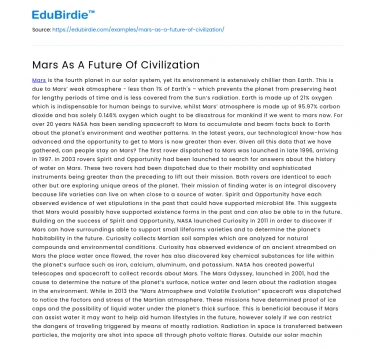Mars is the fourth planet in our solar system, yet its environment is extensively chillier than Earth. This is due to Mars’ weak atmosphere - less than 1% of Earth's – which prevents the planet from preserving heat for lengthy periods of time and is less covered from the Sun’s radiation. Earth is made up of 21% oxygen which is indispensable for human beings to survive, whilst Mars’ atmosphere is made up of 95.97% carbon dioxide and has solely 0.146% oxygen which ought to be disastrous for mankind if we went to mars now.
For over 20 years NASA has been sending spacecraft to Mars to accumulate and beam facts back to Earth about the planet's environment and weather patterns. In the latest years, our technological know-how has advanced and the opportunity to get to Mars is now greater than ever. Given all this data that we have gathered, can people stay on Mars?
The first rover dispatched to Mars was launched in late 1996, arriving in 1997. In 2003 rovers Spirit and Opportunity had been launched to search for answers about the history of water on Mars. These two rovers had been dispatched due to their mobility and sophisticated instruments being greater than the preceding to lift out their mission. Both rovers are identical to each other but are exploring unique areas of the planet. Their mission of finding water is an integral discovery because life varieties can live on when close to a source of water. Spirit and Opportunity have each observed evidence of wet stipulations in the past that could have supported microbial life. This suggests that Mars would possibly have supported existence forms in the past and can also be able to in the future.
Building on the success of Spirit and Opportunity, NASA launched Curiosity in 2011 in order to discover if Mars can have surroundings able to support small lifeforms varieties and to determine the planet’s habitability in the future. Curiosity collects Martian soil samples which are analyzed for natural compounds and environmental conditions. Curiosity has observed evidence of an ancient streambed on Mars the place water once flowed, the rover has also discovered key chemical substances for life within the planet’s surface such as iron, calcium, aluminum, and potassium.
NASA has created powerful telescopes and spacecraft to collect records about Mars. The Mars Odyssey, launched in 2001, had the cause to determine the nature of the planet’s surface, notice water and learn about the radiation stages in the environment. While in 2013 the “Mars Atmosphere and Volatile Evolution” spacecraft was dispatched to notice the factors and stress of the Martian atmosphere. These missions have determined proof of ice caps and the possibility of liquid water under the planet’s thick surface. This is beneficial because if Mars can assist water it may want to help aid human lifestyles in the future, however solely if we can restrict the dangers of traveling triggered by means of mostly radiation.
Radiation in space is transferred between particles, the majority are shot into space all through photo voltaic flares. Outside our solar machine, there are high-energy protons and ions known as galactic cosmic rays which have an unknown effect. Radiation above 50mSv can cause most cancers or injury to the central nervous system in humans whilst astronauts get exposed to 50-2000, fortunately, there are specific materials and compounds that provide great protection, such as lead and even water. For the space station to protect towards gamma rays a guard is built with 13.3ft of water, 6.6ft of concrete or 1.3ft of lead. Astronauts are additionally given spacesuits that furnish protection, while the mental health of astronauts on return is questionable.
Mental health whilst in isolated areas has an unknown effect. NASA has a team of support workforce to assist crewmembers on missions, this group is the ‘Behavioral Health Team’ and they work to decrease the threat of behavioral and psychiatric stipulations for astronauts that go on long-duration missions. Care applications are also sent from domestic or from the assist staff. These are intended to make existence away from home a little less difficult and familiar. Astronauts get the advantage of family cellphone calls any time, thinking about the internet protocol (IP) and can have a video conference as soon as a week the usage of the space station laptop (SSC). To reduce dangers NASA makes certain conversation within a crew is robust and makes certain the astronauts get adequate sleep to shield towards fatigue errors. NASA and private organization SpaceX are the most probable organizations to layout an outing to Mars and work on adapting the atmosphere and environment.
SpaceX – based by way of Elon Musk - is working on creating advanced reusable rockets that may additionally soon be successful of a mission to Mars. CEO, Elon Musk has stated that “humanity could have an outpost on Mars just a decade from now” SpaceX is most likely to gain this due to NASA being a government-funded organization. Meaning funding is by no means secure. Their goal is to land the first human on Mars by 2024, their design started last year in 2019. SpaceX’s foremost thoughts are to create rockets that can tour a few hundred kilometers in order to limit the time in space travel. Elon Musk’s notion to have reusable rockets is a large financial system alternate that will decrease the rate and factors wanted to create these rockets.
Given all the statistics that we currently recognize about Mars, it is broadly mentioned that given ample time we will be successful in growing technological know-how and the use of the planet’s resources for human beings to stay on Mars. Water under the polar ice caps would assist furnish the sources we would need to live there, provided we get there safely and minimize radiation absorption. Elon Musk’s SpaceX employer is most probably going to alter space travel in the subsequent few decades.






 Stuck on your essay?
Stuck on your essay?

